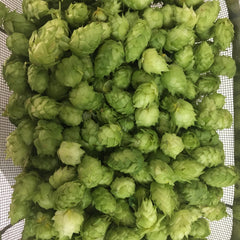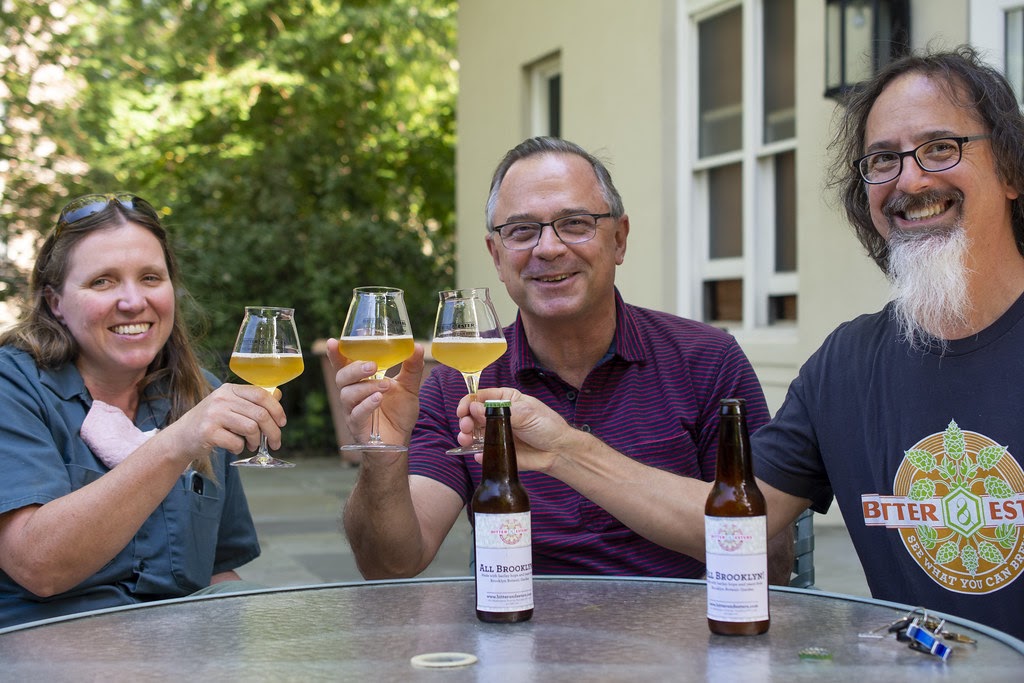Read this article as a print piece, first published by the American Homebrewers Association, 2022.
-
One of my favorite places in Brooklyn (besides Bitter & Esters) is the Brooklyn Botanic Garden. I have been fortunate to both live and work near this amazing place. It is an oasis in the chaos that is NYC.
Over the course of my many trips through the years to the Brooklyn Botanic Garden I’ve befriended Maeve Turner, who runs the Herb Garden there. Maeve is also a homebrewer (great minds think alike) and has been growing Nugget hops at the garden for a few years and generously lets us brew with them at the shop.

This year she grew barley for the first time and asked me if I would like to have it. The funny thing was that she gave me the barley plants, stalks and all. Typically homebrewers get their barley directly from a maltster who has already converted the barley into a finished product that is ready to use, in the form of malted barley. My business partner (Douglas) and I had to hand thresh the barley to remove the seeds from the rest of the plant. This took us several hours and in the end we ended up with a pound and a half of barley.



We weren’t sure if we should just roast the barley to use in a larger batch of beer, or malt it. Malting the barley involves starting the germination of the seed to create enzymes that unleash the starches that will eventually turn to sugar during brewing. We’re always up for a challenge and the opportunity to learn, so we decided to try our hand at malting instead of roasting.
It took us seven days of soaking, sprouting, drying, kilning and cleaning, but in the end we had a pound and a half of malted barley ready for brewing. Such a small amount of barley would only yield about 6 bottles of beer at ~4% ABV. Coincidentally, it’s harvest time for hops as well, so we were able to use barley and hops from the BBG to make our beer.

The last thing we needed was yeast. Yeast are the single-celled fungi that convert sugar into alcohol and it’s an integral part of the brewing process. Usually, homebrewers will purchase a specific strain of yeast from a lab that’s been cultured and built-up so that a healthy amount of yeast will be available to ferment a beer. Given that we were already using barley and hops from the BBG, we thought it only prudent to source our yeast from there as well.



Yeast can be found almost anywhere, especially on fruit. Maeve had given us a few pears from the garden and we cut them up and added them to a barley sugar solution called a starter. There are many other microbes living on fruit besides yeast, so there was no guarantee we would get yeast from the starter. We made four small starters, of which two grew mold (which is not unexpected) but two of them cultivated yeast! You can tell by the smell and look of it that it is yeast. I built these yeast starters up (growing more of the same yeast) by adding them to subsequent starters until I had a healthy slurry of wild yeast. This was thrilling! We were going to make an all Brooklyn Botanic Garden ingredient beer!


With the help of our employee Jack we then proceeded to make the beer. This would be the test to see if we had malted the barley correctly. We added crushed malted barley to water around 155℉, which activates enzymes that were created during the malting process which proceed to break the starches down into fermentable sugars that the yeast will consume and create alcohol. If we did not malt it correctly, this process (called “mashing”) would not happen.


Thankfully, we did it right because the starch converted to sugar! We then took this sweet liquid called wort and boiled it. While boiling we added the hops flower from which the bitterness is extracted to balance the beer's flavor. The aromatic oils of the hop boil away during this time so adding more hops after we were done boiling allowed the hop aroma to remain in the beer. After cooling the wort to room temperature we then did the most important part, adding the yeast (this is called pitching). We had previously made a test beer with the garden yeast to make sure it tasted good (which it did).
The next part of the process involves a whole lot of . . . waiting. We let it sit for two weeks, while the yeast consumed our barley sugar and created alcohol. Once fermentation was finished we transferred the beer into bottles with a little bit of corn sugar. The yeast consumes this sugar and creates CO2 gas that gets trapped in the beer and carbonates it.

The wait was worth it! We ended up with 6 bottles of a golden wild ale. The color was a sparkling hay, the taste reminiscent of a fine saison, crisp and dry. The aroma included peppery phenolics, and dare I say, a hint of pear? The hops balanced the yeast and malt flavors perfectly.

But don’t take my word for it, Maeve was kind enough to set up a meeting for us with Adrian Benepe, president of the Brooklyn Botanic Garden! We sat outside on a terrace on a warm fall day and enjoyed this delicious beer. Both Adrian and Maeve were impressed by the final product and asked if we’d like to do it again next year! Yes, yes we would.

We liked this beer so much that we sent a sample of the BBG yeast to Bootleg Biology for them to isolate. Hopefully in a few months we will have this yeast for sale at the shop!
All in all this was a wonderful learning experience and a way for us to make something truly local. Thank you to Maeve and the Brooklyn Botanic Garden for their help and for providing the ingredients. We hope to do it again next year!
Check our instagram for some videos on how we made this happen!

